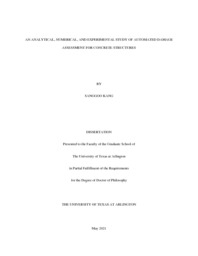
ATTENTION: The works hosted here are being migrated to a new repository that will consolidate resources, improve discoverability, and better show UTA's research impact on the global community. We will update authors as the migration progresses. Please see MavMatrix for more information.
Show simple item record
| dc.contributor.advisor | Ham, Suyun | |
| dc.creator | Kang, Sanggoo | |
| dc.date.accessioned | 2022-07-19T12:01:29Z | |
| dc.date.available | 2022-07-19T12:01:29Z | |
| dc.date.created | 2021-05 | |
| dc.date.issued | 2021-05-09 | |
| dc.date.submitted | May 2021 | |
| dc.identifier.uri | http://hdl.handle.net/10106/30753 | |
| dc.description.abstract | This dissertation presents the automated damage assessment studies for concrete structure. Three major studies are performed to: 1) understand the theoretical wave scattering model to evaluate the internal vertical crack, 2) to validate the theoretical wave scattering model through FE simulations with experimental measurements, and 3) to advance practical automated crack evaluation (ACE) system for vertical crack and delamination detection.
Firstly, singular integral solutions are studied to investigate scattering of Rayleigh waves by subsurface cracks. Defining a wave scattering model by objects, such as cracks, still can be quite a challenge. The model’s analytical solution uses five different numerical integration methods: (1) the Gauss–Legendre quadrature, (2) the Gauss–Chebyshev quadrature, (3) the Gauss–Jacobi quadrature, (4) the Gauss–Hermite quadrature and (5) the Gauss–Laguerre quadrature. The study also provides an efficient dynamic finite element analysis to demonstrate the viability of the wave scattering model with an optimized model configuration for wave separation. The obtained analytical solutions are verified with displacement variation curves from the computational simulation by defining the correlation of the results. A novel, verified model, is proposed to provide variations in the backward and forward scattered surface wave displacements calculated by different frequencies and geometrical crack parameters. The analytical model can be solved by the Gauss–Legendre quadrature method, which shows the significantly correlated displacement variation with the FE simulation result. Ultimately, the reliable analytic model can provide an efficient approach to solving the parametric relationship of wave scattering.
Secondly, the analytical model of internal vertical crack is validated through comparison with parametric studies based on dynamic finite element (FE) simulations and experimental measurement. The results of the study allow to demonstrate crack depth estimation understanding response variation curves, which are the wave response ratio of scattering waves to incident waves according to specific wave frequency and crack geometry. In addition, the study advances the crack evaluation based on the SWS-IVC model leveraging relative wave energy attenuation obtained from arrayed air-coupled MEMS sensors.
Finally, the ACE system is proposed, developed and demonstrated for the rapid bridge deck inspection. The inspection includes detection of delamination, vertical crack, and corroded reinforcement by using flexural vibration mode of impact-echo testing, wave attenuation, and GPR, respectively. The ACE system has novelty in three main techniques: the advanced auto-impacting system, high-speed integrated scanning platform, and high-resolution data collecting system. The advanced auto-impacting system is validated through laboratory tests considering many parameters. Two field bridge inspection are performed with the developed ACE system. The 2-D interpolation colormaps present area of the delamination, vertical crack, and reinforcement corrosion. | |
| dc.format.mimetype | application/pdf | |
| dc.subject | Automated crack evaluation | |
| dc.subject | Concrete structures | |
| dc.subject | Nondestructive testings | |
| dc.subject | Wave scatterings | |
| dc.title | AN ANALYTICAL, NUMERICAL, AND EXPERIMENTAL STUDY OF AUTOMATED DAMAGE ASSESSMENT FOR CONCRETE STRUCTURES | |
| dc.type | Thesis | |
| dc.degree.department | Civil Engineering | |
| dc.degree.name | Doctor of Philosophy in Civil Engineering | |
| dc.date.updated | 2022-07-19T12:01:30Z | |
| thesis.degree.department | Civil Engineering | |
| thesis.degree.grantor | The University of Texas at Arlington | |
| thesis.degree.level | Doctoral | |
| thesis.degree.name | Doctor of Philosophy in Civil Engineering | |
| dc.type.material | text | |
Files in this item
- Name:
- KANG-DISSERTATION-2021.pdf
- Size:
- 7.786Mb
- Format:
- PDF
This item appears in the following Collection(s)
Show simple item record


